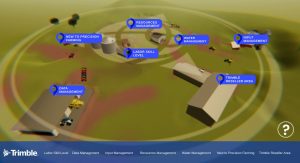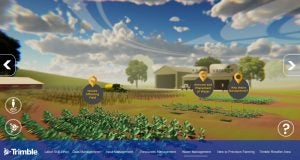To help growers adopt precision and other high-tech solutions to some of the most common problems on a farm, Trimble Agriculture has launched its Virtual Farm. The software explores topics such as labor skill levels, water management, and input management, and then connects the user with opportunities to address those concerns through Trimble’s services. The interactive online farm debuted publicly for the first time at the 2022 National Farm Machinery Show.
“The idea behind it is to explain what Trimble Agriculture does and the areas of your farm that we adapt to. A lot of people recognize Trimble as an autosteer company or GPS company; what they don’t realize is how all-encompassing we are on the farm,” Jake Ridenour, Regional Development Manager at Trimble Agriculture, told AGDAILY.
Trimble’s services include things like spot-spray solutions and working with the sprayer-control system FieldIQ. In past years, Trimble’s trade-show booths have focused on hardware, so the reimagining of this year’s National Farm Machinery Show booth is a way to explain more of what the company is about.
“The idea that Trimble is just a guidance company has been a problem for us for a long time. We do way more than guidance,” Ridenour said.

The Trimble Virtual Farm allows users walk through the digital farm platform and identify challenges they encounter on a day-to-day basis. From there, farmers are directed to Trimble’s solutions for each challenge and can be connected with a Trimble Agriculture representative.
The interactive platform delves into:
- Ensuring Work Gets Done: With seasonal workers and skilled labor challenges, it can be difficult to ensure field work gets done efficiently and accurately. With intuitive workflows, precision agriculture solutions can enable equipment operators to complete field tasks with ease and with minimal training. Automatic implement, field and task selection help operators to work on the correct tasks with the right implement in the right field. In addition, all of the field data is synced directly back to the farm office.
- Start-to-Finish Data Management: Having multiple vehicles working at the same time and getting farm data from one platform to another can be a challenge due to multiple guidance lines, transfer of displays, and transfer of data across the whole operation. Data management solutions help make the most of the farmers’ data by automatically syncing this information to increase efficiencies across the farm.
- Input Management for Cost Savings: Weed management chemicals can be expensive and it can be difficult to ensure spray application is consistent and in the right places. In today’s economy, farmers want to spend less and are looking for ways to create efficiencies through technologies that reduce waste.
- Resource Management to Make the Best Use of Time: It is important for farmers to ensure they can manage land, machinery and time in an efficient manner to create a coherent operation. Ensuring resources are utilized properly and efficiently make farms more profitable altogether.
- Water Management: Nearly every farm has water concerns — whether it be too much water, not enough drainage or simply not knowing how to maximize water to impact the bottom line. Managing water issues can result in year-over-year improvements that significantly impact farm profitability and management.
- Getting Started in Precision Farming: There are several barriers to entry for farmers looking to get started in precision agriculture, including the initial investment in the technology, knowing how to choose the right equipment with ongoing support. Knowing the answer to these questions and showing the ROI gives farmers a way to show how precision farming can significantly change their farming practices for the better.
The Virtual Farm “is targeted to all agricultural growers. There is something that can be found here to help any individual farm, regardless of size,” Ridenour said.



